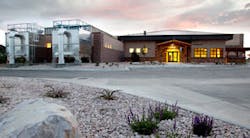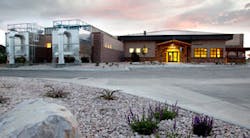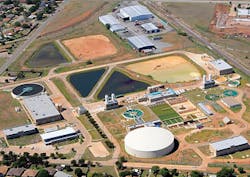Reclaiming a Resource: Wastewater Reuse Holds Promise for Communities Struggling with Drought
By William Atkinson
The technology and systems required for water and wastewater utilities to work together to provide potable water reuse have been in existence for a long time. Traditionally, however, efforts have primarily focused on indirect potable reuse (IPR).
There are currently two strategies for transforming wastewater into potable water. One of these, as mentioned, is IPR, which involves releasing treated wastewater into groundwater or surface water sources. Subsequently, this released water is then reclaimed and treated to become purified water that meets drinking water standards. The other, and newer, method is direct potable reuse (DPR), which involves purifying wastewater and then introducing the purified water directly into a drinking water supply system.
Several communities are considering DPR --along with IPR -- and at least one has actually implemented DPR technology.
Considering DPR and IPR
One utility with a wastewater-to-potable-water project under consideration is in the city of San Angelo, Texas. The utility already has a water reclamation facility designed to treat wastewater such that it is environmentally safe for agricultural irrigation.
But given the persistent dry conditions in Texas, the utility was prompted to take water reclamation to the next level. "Severe drought in West Texas has brought on the need to look at all water sources," said Ricky Dickson, water utilities director. "San Angelo has predominantly relied on surface water only. We are currently developing a groundwater source and wanted to add reuse to our water supply portfolio."
San Angelo has hired a consulting firm to conduct a feasibility study. "The study will concentrate on finding the best and most beneficial use of the reclaimed water," said Dickson. This could include surface water augmentation (pumping reclaimed water to one of the local reservoirs), using the water for large potable water users for irrigation needs (purple pipe system), and/or DPR (pumping the water directly to the water treatment facility).
Given the environmental considerations, Dickson noted that the Texas Commission on Environmental Quality will be heavily involved throughout the project. And the effort is worth it, as Dickson sees it. "There is a potential of adding an additional 5 to 7 million gallons a day (MGD) of water to our supply," he said. "This could provide as much as one-third of our water needs."
Another utility considering both DPR and IPR is in the town of Castle Rock, Colo. "There was no specific event that triggered our interest in potable water reuse," said Mark Marlowe, utilities director. "Castle Rock has done a very good job of studying water resource needs strategically. We developed a Water Resources Strategic Master Plan in 2005 and have continued to review that plan in light of continued growth of the town over time."
Currently, the city is evaluating both DPR and IPR but has not implemented either one -- not yet. "We have come to realize that indirect reuse of our treated effluent is an excellent resource -- both from efficiency and cost standpoints -- so this is something that we plan to look at going forward," Marlowe said. "However, we are also currently evaluating direct reuse in combination with several options for indirect use."
In terms of engineering, the utility has done some very preliminary work, such as looking at combining advanced oxidation with its current membrane treatment processes. "If we do end up going this route, we estimate that we will be able to meet 40 percent to 50 percent of our current demand with indirect reuse water," said Marlowe.
DPR in Action
While a number of utilities are in the process of considering DPR, the city of Wichita Falls, Tex., has actually implemented it. During its previous drought, which was in the late 1990s, Wichita Falls began evaluating both the DPR and IPR options. "The work that we are currently doing during this drought is a continuation of that previous work," said Daniel Nix, public utilities operations manager. The Texas Commission on Environmental Quality has approved the project, and the utility started discharging the treated DPR water to distribution on July 9, 2014.
The wastewater effluent is being disinfected with chloramines in the pipeline between the wastewater plant and the water plant. At the water plant, it is clarified further, micro-filtered, treated with reverse osmosis (RO), blended on-site with lake water, and then treated another time through a complete conventional plant. "The reason we selected these technologies is that they already existed in the city's treatment plants," said Nix. "This was one of the things that made DPR work for us. We didn't have to construct any treatment facilities. All we had to do was connect the two plants with a pipeline."
There are no state regulations for DPR in Texas and no federal regulations either, according to Nix. However, the city of Wichita Falls worked closely with the Texas Commission on Environmental Quality to develop a set of guidelines that would be utilized to ensure the DPR plant performed properly and was adequately monitored. "The intent of the DPR for Wichita Falls was to enhance the conservation efforts that were already in place, to reduce the amount of water being withdrawn from our source lakes," said Nix.
Typically in July, the city, with a population of about 150,000, would withdraw 35 to 40 MGD from its source lakes. With conservation, that amount has been reduced to 12 MGD. Now, with reuse on line, there is an additional five MGD that is not being withdrawn from the lakes. "So, in essence, we have gone from withdrawing 40 MGD from the lakes in July to withdrawing 7 MGD," said Nix. "If the drought persists here in North Texas, we project that with conservation and DPR we will extend our water sources by an additional two years. Hopefully, that is enough to get us to a wetter cycle in our climate."
About the Author: William Atkinson is a correspondent for WaterWorld Magazine. He has been a full-time freelance business magazine writer since 1976, specializing in infrastructure, sustainability, supply chain, risk management, and safety/health.
Convincing the Public
Former Oakland Raiders coach John Madden always enjoyed telling the joke about walking into the locker room just in time to see a football player open his wallet, toss a $20 bill into the toilet bowl, and then begin to reach in to retrieve it.
"What are you doing?" asked an incredulous Madden. The player responded, "I accidentally dropped a dollar bill in the bowl, but I'm not sticking my hand in there just for a dollar."
Obviously, toilet bowls have always had a "yuck factor," so it doesn't help when water utilities in water-scarce communities contemplate the idea of building treatment plants to treat wastewater sufficiently enough to make it potable again, only to have their local newspapers run stories with headlines reading, "Toilet-to-tap project being considered."
How do communities convince the public that potable water reuse is safe? "In terms of making sure the customers understand the need for this, the key is education," said Marlowe. "First, they need to understand the value of water -- that there is a cost to water, that we are trying to provide water to them at the lowest possible cost, and that water reuse is a critical component of doing this."
Second, according to Marlowe, customers need to understand how the process works and that there are technologies in place to make sure the water is safe. "A lot of people don't realize that indirect reuse has been common across this country for many years," he said. "In other words, when you think about it, most people are downstream from somebody. We believe that if you are transparent and present your customers with the facts, the options, and the implications of those options to the best of your ability, you can get their support for ensuring a long-term sustainable water supply, which may include reuse."
The city of Wichita Falls has had a very active public outreach and education campaign. "We have kept the public informed weekly of the lake levels and their decline," said Nix. "Early in the DPR process, while it was still conceptual, we told the public what we were working on. We created a YouTube video describing the process and had several medical doctors and academic Ph.D.'s state that they supported the project. This way, it wasn't just the city staff saying it would work."
More WaterWorld Current Issue Articles
More WaterWorld Archives Issue Articles




